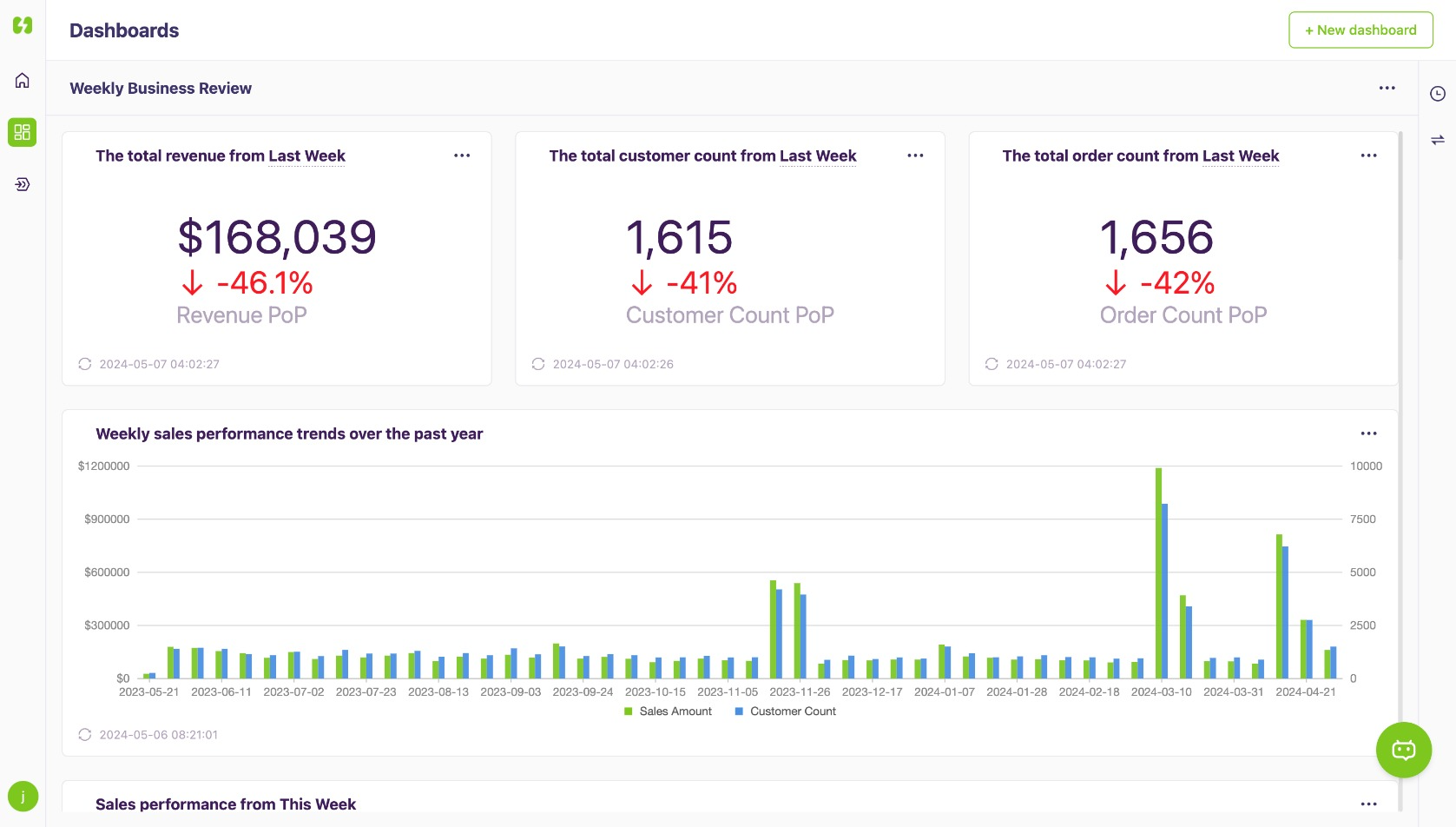Why You Need a Weekly Business Review (WBR)

Many of our clients find themselves in a situation where they lack a data team but still need to review their business performance regularly. A Weekly Business Review (WBR) report is exactly what they need. WBRs are essential management tools that help businesses monitor their progress, address immediate issues, and align team efforts towards common goals. In this blog post, we'll delve into the importance of WBRs, what they should encompass, their benefits, and how to make them actionable.
What is a Weekly Business Review?
The Weekly Business Review ensures a concentrated focus on the essential aspects of your business operations. It engages key personnel and stakeholders in a thorough evaluation of performance metrics, strategic goals, and tactical challenges. The consistency and detailed approach of these reviews empower the company to quickly adjust to shifts in the business landscape or changes in operational performance.
Key Components of a Weekly Business Review
A well-structured Weekly Business Review should include several crucial elements to ensure it provides comprehensive insights and actionable information:
1. Weekly Operational Metrics
This section provides a comprehensive overview of key business metrics, including:
- Customer Volume: Tracking the number of customers engaged with the business.
- Order Volume: The total number of orders placed during the week.
- Sales Volume: Quantity of products or services sold.
- Revenue: Total sales revenue generated.
These metrics offer a snapshot of the business's weekly performance, helping to understand trends and operational efficiency.
2. New Customer Acquisition and Quality
- Source Regions: Identification of geographical areas where new customers are acquired.
- Customer Quality by Region: Assessment of the quality of new customers based on their geographical source. This data supports the evaluation of marketing efforts and strategies aimed at customer acquisition.
3. Product Sales Performance
- Best-selling Products: Analysis of the products with the highest sales volumes.
- Sales Data: Detailed sales figures that guide inventory management and sales strategy planning. This component is crucial for aligning production and marketing efforts with market demand.
4. Refunds Analysis
- Volume of Returns: The number of returned orders.
- Refund Amounts: Total money refunded to customers.
- Product Analysis: Breakdown of refunds by product to identify any recurring issues or trends.
This analysis helps in identifying problem products, understanding customer satisfaction, and maintaining quality control and after-sales services.
5. Performance of New Products
- Sales Performance of New Products: Insights into how newly launched products are performing.
- Regional Sales Data: Analysis of new product sales by region.
This information is vital for supporting the promotion of new products and expanding market reach.
By regularly reviewing these components, businesses can maintain a clear view of their operational success and areas for improvement, ensuring sustained growth and adaptability in a dynamic market environment.
How to Use WBR Report on MagicBean
The Weekly Business Review (WBR) report on MagicBean is very easy to use! We provide valueble templates, one of them is WBR. Here’s how to effectively use this report to optimize your business performance:
- Access the Dashboard: Log into your MagicBean account and navigate to the dashboard.
- Add new dashboard: Choose the “Top 10 products with the highest refund rates” from the report options.
- Select the WBR template: Choose the WBR template from the dashboard template pop-up.
- Preview or use template: Click "preview" button, you can preview the WBR report with your data. Or you can just use this template.
- View Report: The report will generate in seconds.

Benefits of Conducting Weekly Business Reviews
Weekly Business Reviews offer multiple advantages that can significantly contribute to a business’s operational effectiveness and strategic agility:
| Benefit | Description |
|---|---|
| Improved Decision-Making | Regular updates on business performance and market conditions allow for informed and swift decisions. |
| Increased Agility | WBRs help businesses respond more effectively to market changes and internal challenges. |
| Enhanced Communication | Facilitates better alignment and communication across different departments. |
| Focus on Objectives | Keeps teams focused on short-term objectives while aligning with the strategic long-term goals. |
| Problem Resolution | Allows for the early identification and resolution of issues before they escalate. |
Making Weekly Business Reviews Actionable
To maximize the effectiveness of Weekly Business Reviews, they should be designed to lead to clear and actionable outcomes:
- Set Clear Objectives: Each review should have a clear agenda and objectives to ensure that all discussions are focused and relevant.
- Involve the Right People: Ensure that all key stakeholders are present in the meeting to provide insights and take decisions.
- Prepare in Advance: Participants should come prepared with all necessary data and reports to make the review productive.
- Focus on Actionable Insights: Emphasize discussions that lead to decisions and actions rather than merely stating facts.
- Follow-up Mechanisms: Establish a system to follow up on the action items and decisions taken during the WBRs to ensure implementation.
Weekly Business Reviews are a vital tool in a company's arsenal to ensure sustained business performance and alignment. By focusing on the right components and making the reviews actionable, businesses can significantly enhance their operational efficiency and strategic execution. Implementing regular WBRs is not just about staying updated; it's about actively shaping the future of the company.



